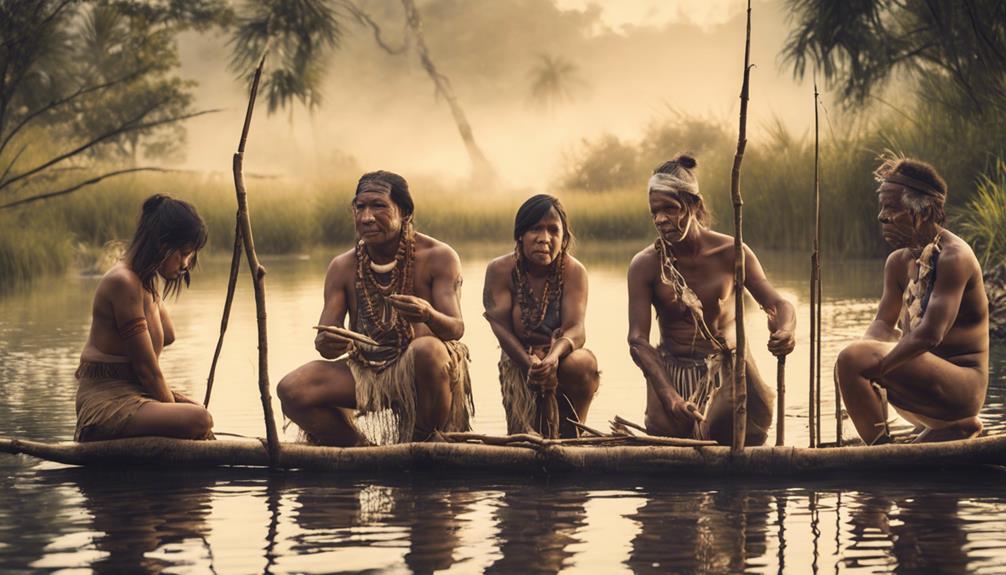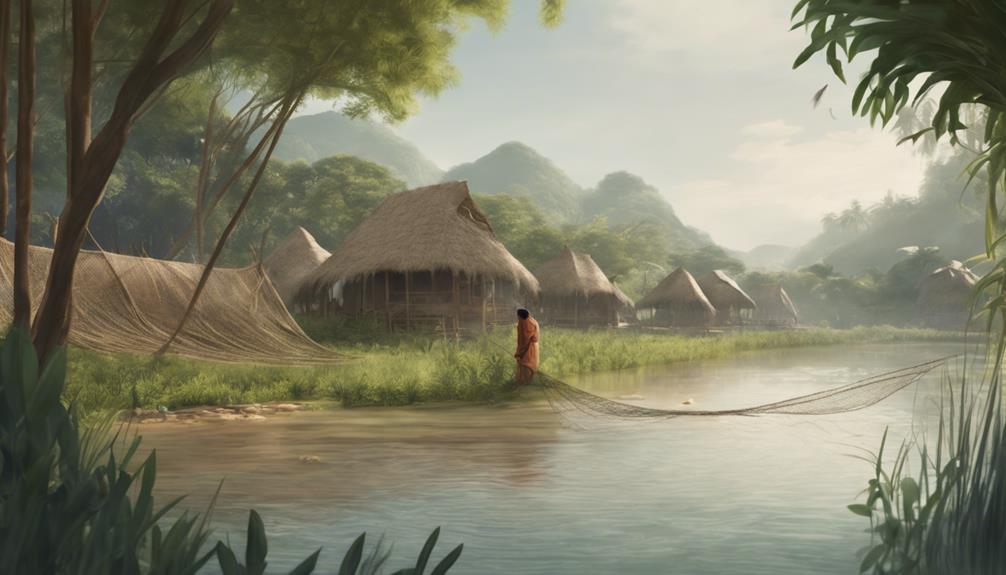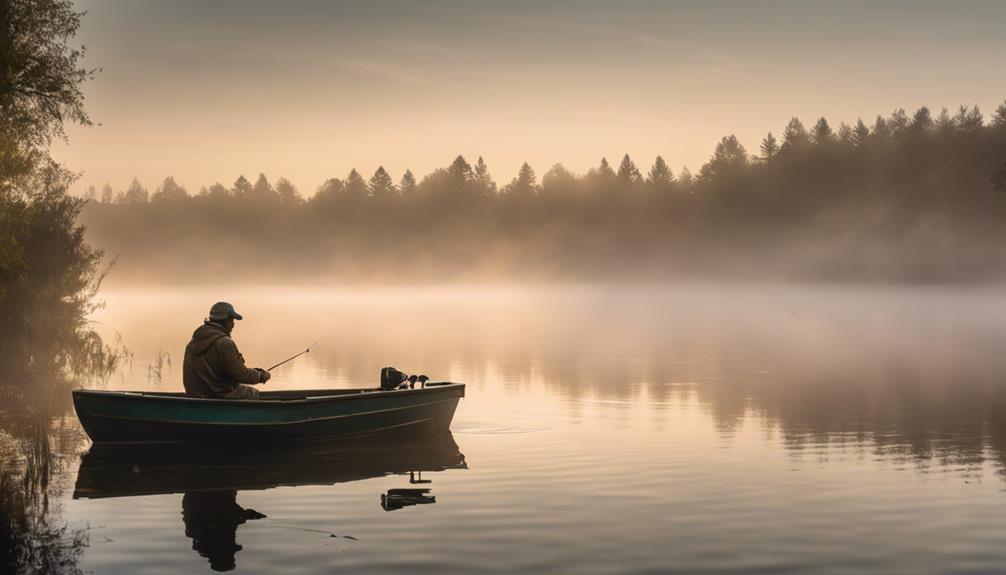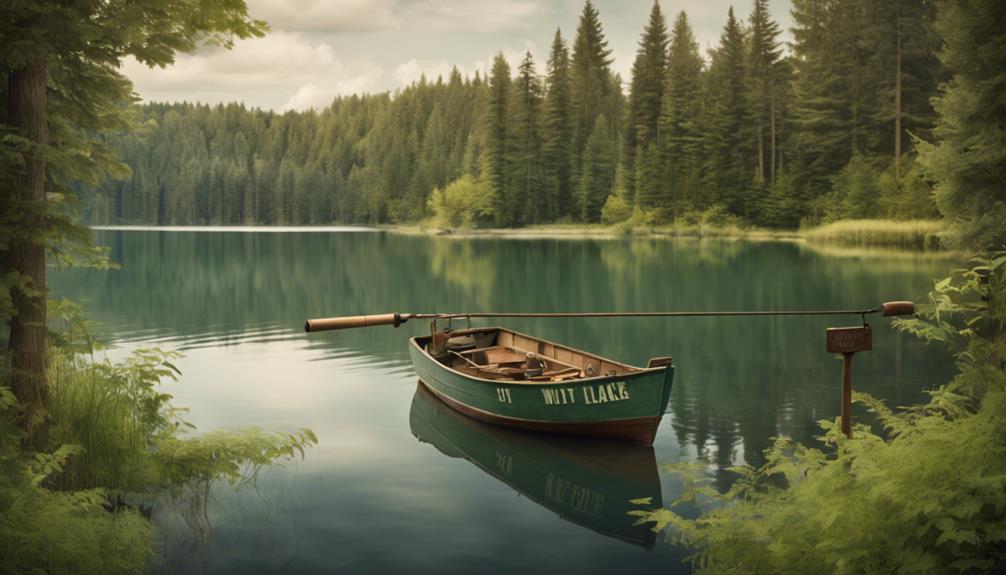Curious about how indigenous tribes perfected their historical angling techniques?
Imagine the intricate methods they used to catch fish in harmony with nature.
From crafting tools to intricate net fishing, their practices were a blend of skill and tradition.
These ancient techniques offer a glimpse into a world where fishing was not just a means of sustenance but a way of life deeply intertwined with cultural beliefs.
Discover the secrets behind their sustainable practices and the evolution of indigenous angling that continues to inspire modern fishermen worldwide.
Ancient Fishing Tools
Ancient fishing tools were ingeniously crafted by early civilizations to enhance their fishing prowess and ensure successful catches. Primitive gear such as harpoons, spears, and nets were commonly used by these ancient cultures. These tools weren't only practical but also held significant cultural importance, reflecting the traditions and techniques passed down through generations.
The use of harpoons was a common practice among many indigenous tribes. Crafted from materials such as bone, wood, or sharpened stones, these tools were designed for precision and power. Harpoons were especially effective for hunting larger fish or even marine mammals, showcasing the skill and resourcefulness of these early fishermen.
Another essential tool in ancient fishing was the spear. Fishermen would wade into shallow waters or stand on boats, carefully aiming their spears to catch fish swiftly. The design of these spears varied across different cultures, with some featuring multiple prongs for increased efficiency. The mastery of spearfishing required patience, agility, and a deep understanding of aquatic ecosystems.
Nets were also widely utilized by ancient fishermen, providing a versatile method for catching fish in various environments. These nets were intricately woven and strategically deployed to trap fish as they swam by. The art of net fishing required knowledge of tides, currents, and fish behavior, making it a skill that was honed over time through experience and observation.
Traditional Bait and Lures
Traditional bait and lures play a crucial role in indigenous angling techniques, enticing fish with natural and culturally significant offerings. These traditional methods not only serve the practical purpose of catching fish but also hold deep cultural and spiritual meanings for indigenous tribes.
Traditional Bait and Lures:
- Natural Materials and Handmade: Indigenous tribes craft their bait and lures from natural materials found in their surroundings, such as feathers, bones, shells, and plant fibers. These items are meticulously handmade, often passed down through generations, showcasing the skill and artistry of the tribe members.
- Cultural Significance and Spiritual Connection: Each bait or lure used in indigenous angling is infused with cultural significance and a spiritual connection to the natural world. These items aren't merely tools for fishing but symbols of respect for the environment and the tribe's heritage.
- Symbolism and Rituals: The choice of bait and lures is often intertwined with symbolism and rituals that reflect the tribe's beliefs and traditions. For example, specific colors or patterns on the lures may represent important aspects of tribal life, while the act of preparing the bait could involve ceremonial practices to honor the fish and the waters they come from.
Indigenous Net Fishing Methods
Indigenous communities employ innovative net fishing methods that demonstrate a harmonious relationship with their aquatic environment. Net fishing holds immense cultural significance for fishing communities, reflecting their deep-rooted traditions and sustainable practices. These methods not only provide sustenance but also showcase a profound understanding of the delicate balance between human needs and environmental impact.
The use of nets in indigenous fishing practices highlights the efficiency and effectiveness of traditional techniques. These nets are meticulously crafted, often by hand, using materials sourced sustainably from the surrounding environment. The process of net making is a skill passed down through generations, symbolizing the interconnectedness between community members and their natural surroundings.
Net fishing also plays a crucial role in maintaining the ecological equilibrium of aquatic ecosystems. Unlike modern industrial fishing practices that can lead to overexploitation and habitat destruction, indigenous net fishing methods are designed to minimize environmental impact. By selectively targeting specific fish species and respecting seasonal migration patterns, these practices ensure the long-term sustainability of marine resources.
Historical Spearfishing Techniques
Explore the historical techniques of spearfishing, revealing a unique approach to harvesting aquatic resources that complements indigenous net fishing methods. Spearfishing has been a vital practice for indigenous tribes, offering a different set of strategies and cultural significance compared to other fishing methods.
Spearfishing Strategies:
- Precision and Skill: Spearfishing requires a high level of precision and skill to target specific fish, showcasing the expertise of indigenous fishermen in understanding aquatic ecosystems.
- Use of Tools and Techniques: Historical techniques involved the crafting of specialized spears and the knowledge of underwater terrain to effectively catch fish, highlighting the resourcefulness of indigenous communities.
- Sustainable Harvesting: Unlike modern industrial fishing methods, spearfishing often focused on sustainable harvesting practices, minimizing environmental impact and preserving aquatic biodiversity.
The cultural significance of spearfishing goes beyond mere sustenance, as it's often intertwined with spiritual beliefs and tribal traditions. The act of spearfishing wasn't just about catching fish but also about maintaining a harmonious relationship with nature.
Furthermore, the historical techniques employed in spearfishing demonstrate a deep understanding of the environment and the need to ensure the long-term health of aquatic resources. By exploring these historical spearfishing practices, we gain insight into the sustainable fishing methods of indigenous tribes and the lessons they offer in environmental stewardship.
Unique Canoe Fishing Practices
Amidst the vast waters, canoe fishing practices offer a distinct perspective on the art of angling. Canoe fishing innovations among Indigenous tribes showcase a deep understanding of water ecosystems and fish behavior. The use of canoes for fishing goes beyond mere transportation; it embodies a harmonious relationship between the angler and the water.
Indigenous paddle techniques play a crucial role in canoe fishing. The way paddles are maneuvered not only propels the canoe but also aids in stealthily approaching fish-rich areas. These techniques have been honed over generations, allowing for efficient and effective navigation through various water bodies. The silent glide of a canoe propelled by skilled hands is a testament to the seamless integration of human movement with nature's rhythm.
In canoe fishing, the design of the canoe itself is often tailored to suit specific fishing needs. Some canoes are equipped with storage compartments for fishing gear, while others are built for stability in rough waters. These adaptations demonstrate the resourcefulness of Indigenous communities in optimizing their fishing experiences.
Sacred Rituals and Fishing
Incorporating sacred rituals into the act of fishing adds a profound spiritual dimension to the angling experience. For many indigenous tribes, fishing goes beyond a mere means of sustenance; it's a sacred practice that fosters deep spiritual connections with nature and the ancestors.
3 Ways Sacred Rituals Enhance the Fishing Experience:
- Preservation of Tradition: Ritualistic practices passed down through generations ensure that the spiritual essence of fishing remains intact. These rituals often involve offerings to the water spirits or prayers for a bountiful catch, reinforcing the connection between the angler and the natural world.
- Harmony with Nature: By engaging in sacred rituals before casting their lines, fishermen acknowledge their place within the ecosystem and seek to maintain a balanced relationship with the environment. This reverence for nature instills a sense of responsibility towards conserving marine life and preserving the delicate aquatic habitats.
- Community Bonding: Participating in sacred ceremonies before embarking on a fishing expedition not only strengthens the individual's spiritual connection but also fosters a sense of unity within the community. These rituals create a shared experience that binds the tribe together, promoting cooperation and mutual respect among its members.
Sustainable Fishing Practices

To ensure the longevity of fish populations and protect marine ecosystems, adopting sustainable fishing practices is crucial. Indigenous tribes have long understood the importance of ethical harvesting and community conservation when it comes to fishing. For these communities, fishing goes beyond mere sustenance; it holds deep cultural significance and is intertwined with environmental stewardship.
Ethical harvesting practices involve respecting traditional fishing grounds and only taking what's needed. Indigenous tribes have passed down knowledge through generations on when and where to fish, ensuring that fish populations remain stable. By practicing ethical harvesting, these communities maintain a delicate balance between human needs and the preservation of marine ecosystems.
Community conservation plays a vital role in sustainable fishing practices among indigenous tribes. By working together to establish fishing regulations and protected areas, these communities actively participate in safeguarding their natural resources. This collaborative approach not only benefits the fish populations but also fosters a sense of unity and responsibility among community members.
The cultural significance of fishing for indigenous tribes can't be overstated. It isn't just about catching fish; it's a way of connecting with ancestral traditions and honoring the environment that sustains them. Through their commitment to ethical harvesting, community conservation, and environmental stewardship, indigenous tribes serve as exemplary models of sustainable fishing practices for present and future generations.
Evolution of Indigenous Angling
The evolution of indigenous angling techniques showcases a rich tapestry of traditional knowledge and adaptive practices passed down through generations. These techniques haven't only sustained cultures but have also evolved to meet the challenges of a changing environment.
- Cultural Practices
Indigenous angling has deep cultural roots, with fishing often intertwined with spiritual beliefs, ceremonies, and social customs. The evolution of angling techniques reflects a deep respect for the natural world and a harmonious relationship with aquatic ecosystems.
- Environmental Impact
As indigenous communities have adapted their angling practices over time, there's been a keen awareness of the environmental impact of their fishing methods. Traditional knowledge has guided them in practicing sustainable fishing, ensuring the preservation of fish populations and the health of water bodies.
- Adaptation and Innovation
The evolution of indigenous angling techniques underscores the communities' ability to adapt to changing environmental conditions. Through innovation and a deep understanding of their surroundings, indigenous peoples have modified their fishing practices to mitigate environmental impact while maintaining cultural practices.
Indigenous angling techniques continue to evolve, balancing cultural heritage with environmental sustainability. By honoring traditional knowledge and adapting to modern challenges, these practices serve as a testament to the resilience and ingenuity of indigenous communities.
Frequently Asked Questions
How Did Indigenous Tribes Navigate Their Way to the Best Fishing Spots?
When Indigenous tribes navigated to prime fishing spots, they relied on their knowledge of the land and waterways. By combining traditional navigation methods with cultural beliefs, they were able to locate abundant fishing grounds.
Fishing rituals played a significant role in this process, as they often involved ceremonies to honor the spirits of the water and ensure a successful catch. These practices not only sustained their communities but also strengthened their connection to the land.
What Role Did Women Play in Ancient Fishing Practices Within Indigenous Tribes?
In ancient fishing practices within indigenous tribes, women's roles were significant. They played crucial roles in traditional practices such as preparing fishing gear, preserving the catch, and passing down fishing knowledge to the younger generations.
Women's contributions ensured the success and sustainability of fishing activities within the community. Their involvement in various aspects of fishing highlighted the importance of gender equality and cooperation in maintaining a balanced ecosystem.
Were There Any Specific Superstitions or Taboos Surrounding Fishing Among Indigenous Tribes?
When it comes to fishing among indigenous tribes, superstitions, taboos, and rituals were deeply intertwined with daily life. Beliefs in spirits inhabiting waterways or in certain fish being sacred led to specific customs. Breaking these taboos was believed to bring bad luck.
Folklore and traditions passed down through generations shaped how fishing was approached, making it not just a practical activity but a spiritual one as well.
How Did Indigenous Tribes Pass Down Their Fishing Knowledge From Generation to Generation?
To pass down their fishing knowledge, indigenous tribes relied on oral traditions and experiential learning. Elders shared their expertise through stories and hands-on teaching, ensuring each generation mastered the art of fishing.
By practicing alongside seasoned fishermen and absorbing wisdom through storytelling, younger members absorbed the techniques and traditions necessary for successful angling.
This method of passing down knowledge ensured that the ancient fishing practices remained alive and thriving within the community.
Did Indigenous Tribes Have Any Special Techniques for Preserving Fish for Future Consumption?
When it comes to preserving fish for future consumption, indigenous tribes had special techniques that reflected their deep connection to nature and cultural sustainability.
Traditional preservation methods like smoking, drying, salting, and fermenting were utilized to ensure a long-lasting food supply.
These methods not only preserved the fish but also honored the tribe's traditions and respect for the environment.
Conclusion
As you delve into the historical angling techniques of indigenous tribes, you gain a deeper appreciation for their ingenuity and connection to nature.
From ancient fishing tools to unique canoe fishing practices, these communities have developed sustainable methods that have stood the test of time.
By exploring their traditional bait and lures, net fishing methods, spearfishing techniques, and sacred rituals, you uncover a rich tapestry of knowledge that continues to evolve and inspire modern anglers.



